By Alex Moody
You’re the officer in charge of a heavy rescue that has been dispatched to an accident on the highway. The call notes mention a smaller vehicle being crushed by a trash truck that rolled onto its side.
On arrival, you learn that the trash truck was fully loaded and headed to the dump. It’s obvious that your crew will need to perform a lift, but can your equipment pull it off? And, do you even have enough of it?
Questions like these should be answered long before this incident ever happens. When designing a new rescue, your department has a lot of decisions to make. Body style, number of axles, overall length—a litany of questions that all need to be answered. But, what informs those decisions? The answer is deceptively simple: tool selection.
Typically, at a minimum, heavy rescues are responsible for vehicle accidents and fireground search operations. In many jurisdictions, they also get attached to specialty teams such as technical rescue. Larger cities, and even larger county departments, have the luxury of dividing disciplines among multiple heavy rescues, while smaller jurisdictions may have to make do with a single unit.
On the surface, it seems easy enough to figure out. Extrication tools, firefighting tools, stabilization equipment, and cribbing will check all of the boxes needed to make up a rescue complement. That said, if you’re reading this, you know the devil is in the details. Do you want to stick with the tried-and-true hydraulic pump for the extrication tools? Or, is it time to make the switch to battery-powered tools? How much cribbing are you carrying? How many stabilization struts does a rescue need?
While contemplating those questions, you also need to consider the name: “Heavy Rescue.” Simply adding the word “heavy” to the name doesn’t make it a more capable unit. Are you responding only to 2,000-pound commuter cars and 5,000-pound SUVs? In the world of vehicle rescue, those are not the only hazards. Commercial vehicles travel through virtually every jurisdiction and can weigh up to 80,000 pounds or more in some states. Commercial vehicles are a hazard unto themselves, and choosing which tools you are going to carry means acknowledging this fact.
In terms of official guidance for these decisions, the pickings are rather slim. National Fire Protection Association (NFPA) 1900, Standard for Aircraft Rescue and Firefighting Vehicles, Automotive Fire Apparatus, Wildland Fire Apparatus, and Automotive Ambulances, has guidance for receivers, anchors, and winches. NFPA 1960, Standard for Fire Hose Connections, Spray Nozzles, Manufacturer’s Design of Fire Department Ground Ladders, Fire Hose, and Powered Rescue Tools, covers performance and design standards for extrication tools and lifting bags. It’s also worth noting that many states have minimum equipment lists that will need to be referenced.

1 Cribbing being used to hold a heavy load in a confined space drill that may require a unit to carry more cribbing than necessary on passenger vehicle accidents. (Photos by author unless otherwise noted.)
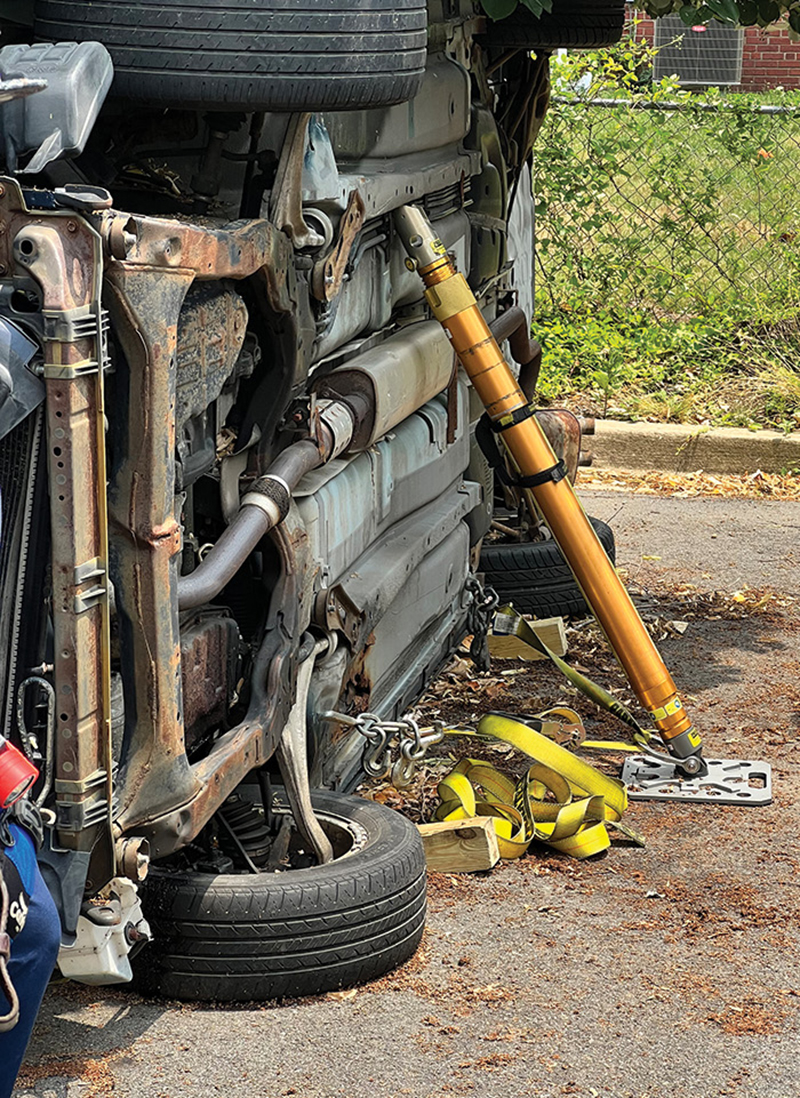
2 A strut being used to stabilize a passenger vehicle during a drill. The strut can hold 20,000 pounds and is well within its capacity. The bottom ratchet strap is attached to two points on the vehicle, providing a large footprint to stabilize the vehicle.
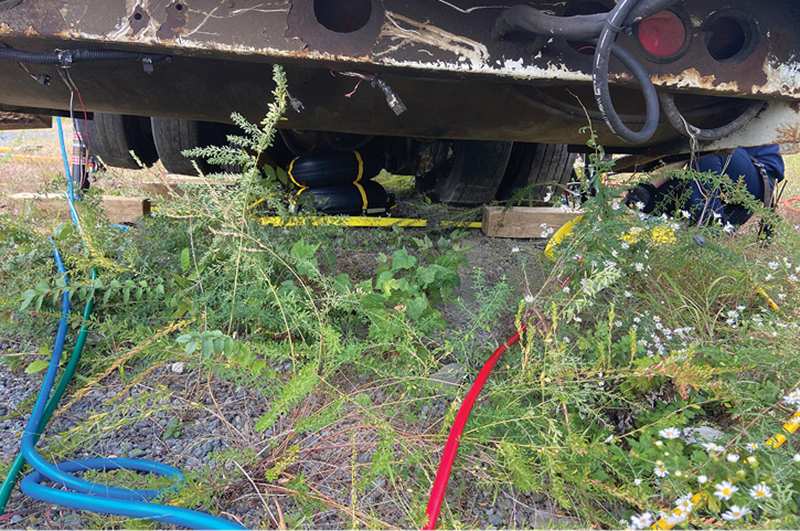
3 Testing a new air bag at a drill. There were “chase struts” providing progress capture for the lift and additional lift struts in place in case of failure. Using struts for progress capture can reduce the amount of cribbing required for an incident.
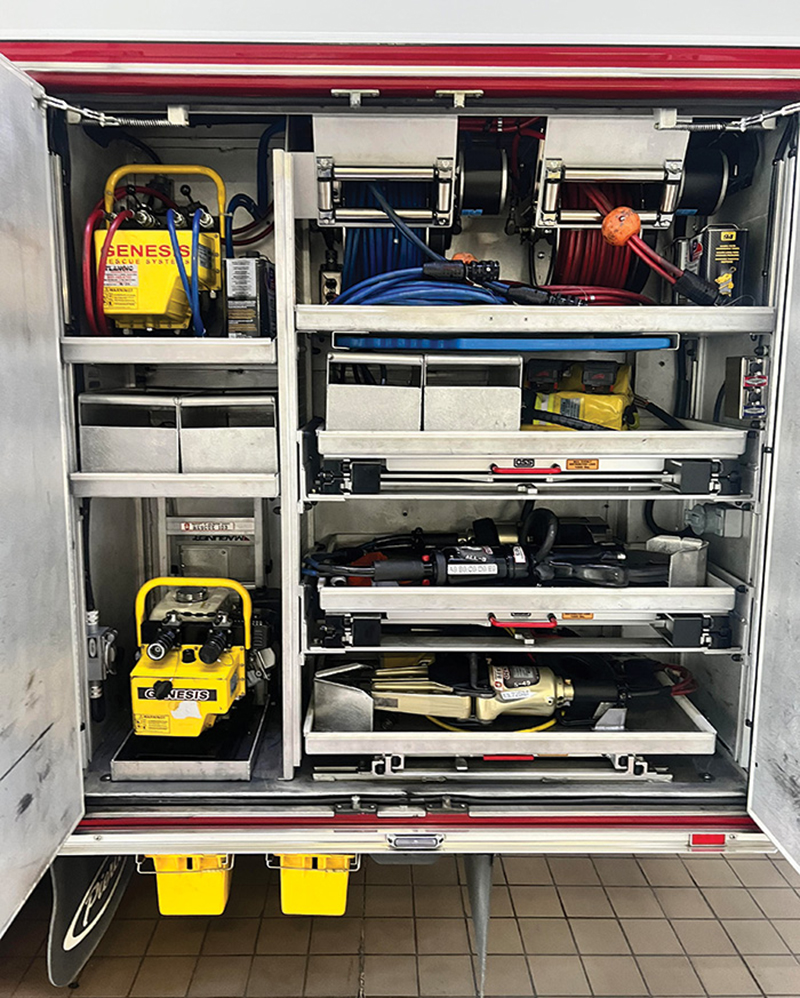
4 A compartment on a rescue that still has traditional hydraulic tools. There is a lot of space taken up by reels, an onboard hydraulic generator, and a portable hydraulic generator. There are only three actual hydraulic tools in this compartment.
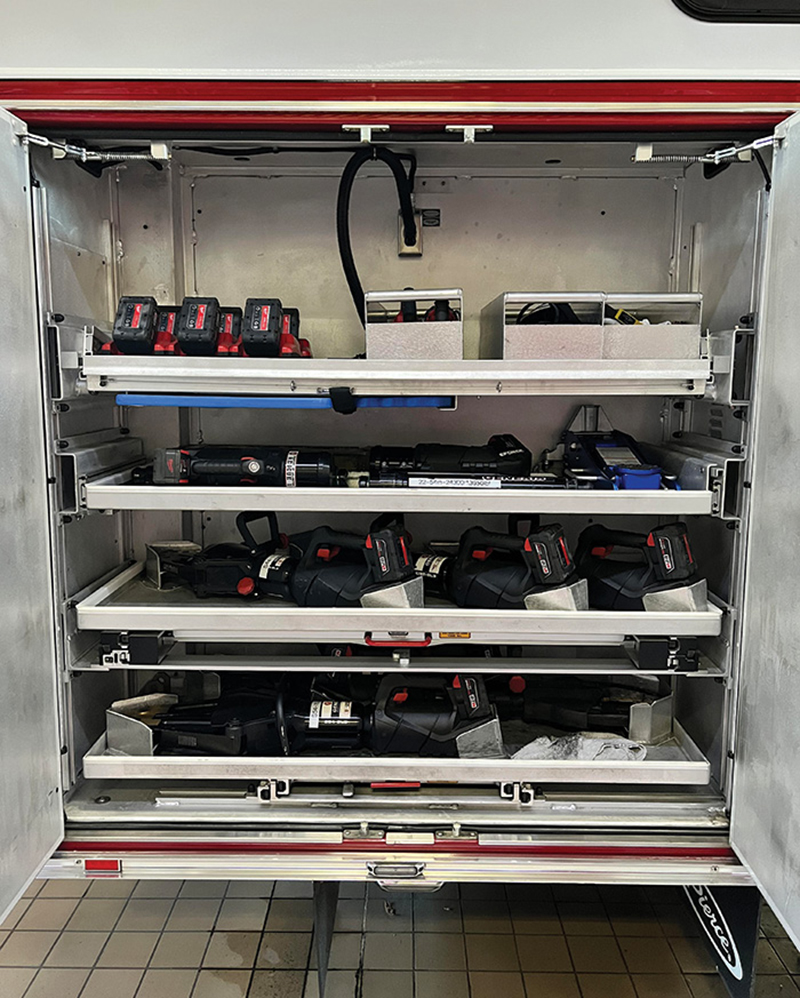
5 A compartment that has a complement of fully battery-powered extrication tools. There are a total of seven tools in this compartment.
CRIBBING
The most basic piece of equipment used in vehicle rescue is cribbing, and even it comes with its own set of questions. What type of cribbing are you going to use? How much of it do you want to carry? If either of those questions left you scratching your head, this section is for you. Cribbing boils down to three options: hardwood, softwood, and plastic.
The Federal Emergency Management Agency (FEMA) recommends a softwood, like Douglas Fir or Southern Pine. The species you end up with generally depends on your location in the country and isn’t worth getting too in the weeds about. The scientific qualities of softwood are well documented for this purpose by FEMA. Put into everyday firefighter terms, it crushes before it fails and makes a lot of noise doing it. These two attributes give rescuers plenty of time to comprehend that something is going wrong.
If softwood is so good, the logical conclusion one could draw is that hardwood is even better. While hardwood does generally carry a higher capacity strengthwise, it offers fewer warning signs before failing. It is also worth noting that the cost of hardwood is significantly higher than your faster-growing softwoods.
The last option is cribbing made out of plastic or composite materials. Composite cribbing is incredibly strong. Not only that, the strength of a composite is more predictable than wood because it can be tested and reproduced to an exact specification. Wood cribbing capacities are essentially based on averages; there is little to no quality control work going into the lumber you purchase.
Composite cribbing offers little to no warning of failure and is more expensive than wood cribbing. It also needs to be ordered from a manufacturer, whereas wood can be bought from your local home improvement store as needed and cut to your specifications.
In terms of quantity, there is less science to this decision. On my rescue, our complement is 48 4×4s, 20 6×6s, 20 2×4s, 8-step chocks, and a few bins of wedges. Before this load, we carried half of that amount. Are either of those complements correct? That’s definitely up for debate. This rig, in particular, is equipped to lift a large distance. If your company won’t be performing large lifts, then carrying less cribbing is an option. The point is this: Make a conscious decision; don’t just throw it on there.
Keep in mind that cribbing is a consumable tool. It degrades over time with use and ages faster than any other piece of equipment we will discuss. It should be inspected and replaced regularly depending on how often it is used.
STRUTS
In addition to cribbing, struts are an incredibly versatile addition to your vehicle, ranging in capacity from 2,500 pounds all the way up to 20,000 pounds. If your heavy rescue will respond to collapse and trench emergencies, buying struts that can work at the heavier end of that spectrum and in each of those disciplines is where you will find the most bang for your buck. For departments where the unit won’t be responding to such incidents, there are cheaper options specifically for use in vehicle stabilization.
When considering your choice, pay attention to where your crews will need to operate in the event of having to perform a lift. Mechanical jack-style struts may have hand cranks that put your members operating right at the point of lift, leaving little room for escape should something go wrong. Hydraulic struts generally have hoses that allow your members to maintain a safer distance.
While the capacity of your struts is a major concern, you can increase that capability through the use of more struts. For example, you respond to a school bus that rolled on top of a passenger car, and the school bus weighs 20,000 pounds. In theory, a 20,000-pound strut can handle it, right? Obviously not. Even if you’re only dealing with half the weight, one strut isn’t going to stabilize a vehicle that long. You will likely end up with at least two to four struts, meaning you could have nearly 80,000 pounds of capacity being used to simply keep 10,000 pounds from going anywhere. This means that maybe your department can get away with slightly less capable struts rated for 10,000 pounds but carry more of them.
AIR BAGS
For even more lifting capacity, a staple of heavy rescue apparatus is the high-pressure air bag. This toolset offers literally tons of lifting capacity for a rather small storage footprint. While not as flashy as struts, air bags are durable and time-tested tools that shouldn’t be ignored.
Most air bag manufacturers will recommend not stacking more than two high-pressure bags on top of each other. They will also tell you that you should have a larger air bag on the bottom and stack an equal or lesser air bag on top. Keep this in mind and do not feel the need to buy 20 high-pressure air bags. The amount of cribbing you carry can also allow you to perform more resets with fewer bags.
As for storing air bags, be sure to leave ample room in your compartment for the air supply, pressure regulator, and controller setup. There are few things more annoying than having to open multiple compartments at 3 a.m. to perform a single operation.
EXTRICATION TOOLS
The world of extrication tools has seen rapid advancement in the past decade. It was once a foregone conclusion that you would need to have space for a hydraulic pump and multiple hose reels to power these tools. Many an apparatus committee has been bogged down arguing over which compartment is best for these pieces of equipment.
These days, you have another choice: Get rid of the pumps and hoses completely and switch to battery-powered tools. Ten years ago, this would have been laughed at in most places, and as little as five years ago this would be seen as a very expensive “trust fall” exercise for departments. Despite the fire service’s historic dislike of change, these tools have proven themselves in the field and are being widely accepted as the future of extrication tools.
Battery-powered hydraulic tools are now just as strong as their traditional counterparts but weigh much less. Departments also no longer need to account for the weight and space taken up by the onboard hydraulic pump, hose reels, and portable pump for those hard-to-access incidents. For smaller departments low on funds, this may mean a single-axle apparatus is back in the cards. Their mobility also all but eliminates the age-old argument about which compartment they have to be stored in or, depending on your committee, complicates the argument.
All of that being said, traditional hydraulic tool complements are still produced and remain a reliable platform for vehicle extrication. An advantage to going the traditional route is that you won’t have to provide space for spare batteries and the accompanying charging bank. Batteries should also be considered a consumable piece of equipment. They will age, their capacity will be reduced, and they will ultimately cost you money to replace.
Another aging yet reliable piece of technology is onboard air for pneumatic tools. Battery-powered hand tools have largely replaced the need for these large onboard tanks and hose reels. They still work, obviously, and can still be used, but be sure to discuss whether this legacy toolset is what your department needs.
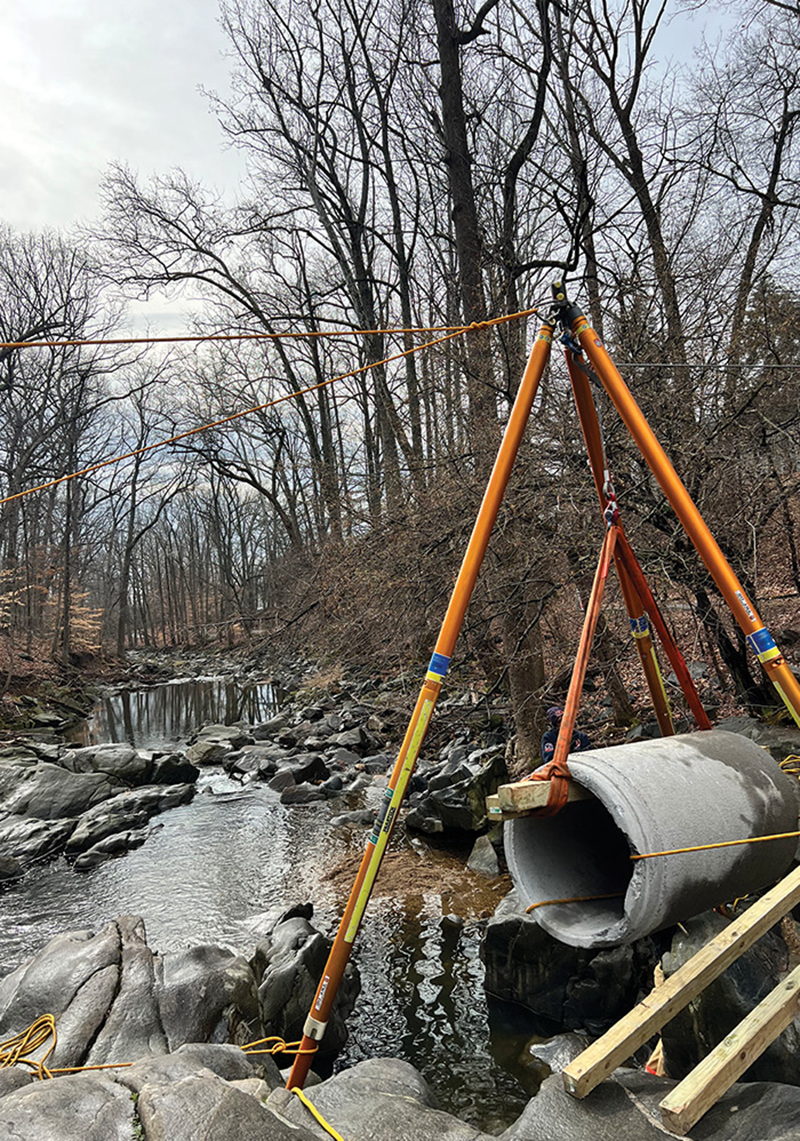
6 Struts being used in a technical rescue scenario. These longer struts are typically not used on vehicle rescues but are carried by the heavy rescue, which requires more space and capacity on the apparatus.
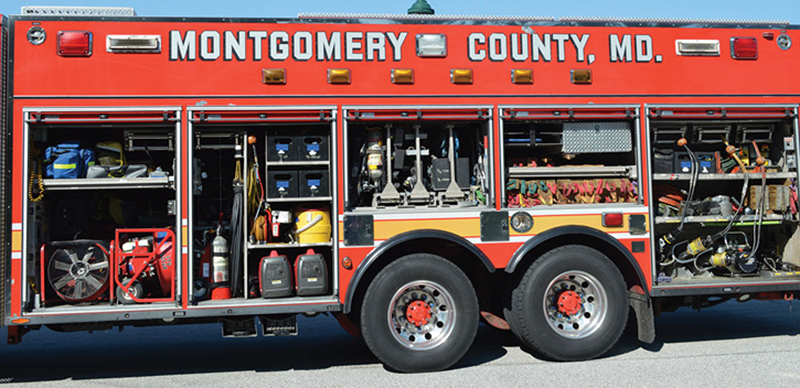
7 An example of how much equipment can be carried on one side of a tandem-axle heavy rescue. (Photo 7 courtesy of Tom Shand.)
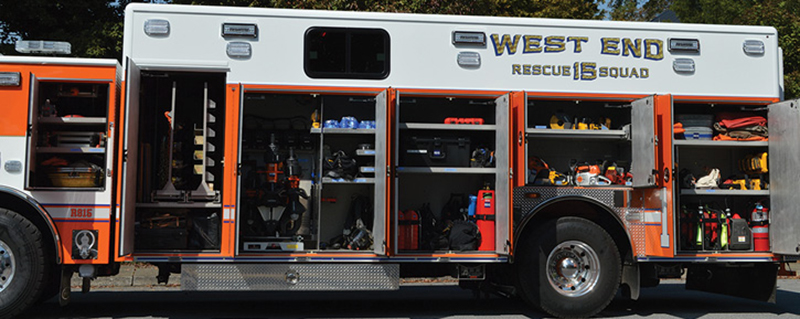
8 An example of how much equipment can be carried on one side of a single-axle heavy rescue. (Photo 8 courtesy of Tom Shand.)
FIREGROUND
The rescue company’s responsibilities on the fireground can be as diverse or as limited as you need them to be. Search and rescue is the easiest task to come up with and will require forcible entry tools, search/tag lines, and RIT equipment as a minimum.
A complement of hooks, saws, and fans may be something you need to consider. Typically, these tools belong in the realm of truck companies. For departments where a responding truck company is consistently nearby, this may be less of a concern. Conversely, departments where the rescue could be operating without immediate or consistent truck support may need to prioritize these tools.
At a minimum, a chainsaw and a rotary saw should be included. The rescue may not be tasked with vertically ventilating, but these tools may be needed on vehicle accidents into trees. Rotary saws have the added utility of being able to make quick work of gaining access to side C of strip malls and other commercial structures.
This is the category where your committee must resist the urge to throw every single hand tool ever created into your compartments. Carefully consider how many people will be staffing the rig and outfit the apparatus accordingly. While rescue companies are considered “toolboxes on wheels,” you don’t want it to turn into an overcrowded and unorganized dumping ground. I personally took off eight sets of irons from a heavy rescue that was only ever staffed with four people—to call that egregious would be an understatement.
SPECIALIZATION
The beauty of staffing a heavy rescue is that it can be outfitted for a wide variety of target hazards. Typically, but not always, the normal job requirements of a heavy rescue tend to overlap with the world of technical rescue. While it may not be required for a heavy rescue to be capable of high-angle rope rescue or complex intersecting trenches, this is the perfect unit to adapt to those emergencies if your response area needs it. That being said, hazmat and water rescue equipment can just as easily be stored on these rigs as well, given the needs of your area.
Certainly, the ability to operate in a low-angle rope rescue would be a valuable capability. With modern technology, descent control devices (DCDs) are much more accessible and easy to learn with proper training. Having rope to help victims, rescuers, and Stokes baskets make their way up and down embankments next to roadways feels like common sense.
TRAINING
Training is the elephant in the room that comes last because I implore you to take it the most seriously. All of the tools discussed here are useless without proper training. For most of us, this comes as no surprise: Every single piece of equipment I’ve discussed can kill you, your firefighters, or your citizens if used improperly.
High-quality training has never been more accessible to the fire service than it is today. Reputable manufacturers also usually offer training to go along with their equipment, but it should not be the only resource you use for training. Seek out experts in the disciplines you will outfit your heavy rescue with and use them to keep you and your citizens safe.
Heavy rescues are not the most complex units to construct. The “toolbox on wheels” moniker I used earlier isn’t a huge exaggeration, but you and your department must be mindful of the tools you choose to store in it. These tools are what actually make your heavy rescue what it is, not the number of axles or the fancy name on the side. As to the number of axles, a rule of thumb is that a single-axle unit can carry 6,000 to 8,000 pounds of equipment. A tandem-axle rescue can carry 10,000 pounds plus. One way to think of it is a single-axle rescue is a great option for vehicle extrication. If this unit is going to be used regionally or for any special operations, the tandem-axle vehicle is probably a better fit. These are just guidelines to help steer your decision into the type of vehicle you may require. The important thing is to understand the equipment carried and the weight of that equipment. You do not want to overload your vehicle.
This just scratches the surface of what goes into making a heavy rescue truly capable of heavy rescue work. Use your apparatus committees and this article as a stepping-off point to make good, sound decisions. In addition, find departments that are performing the way you want to perform and are using the equipment you want to use. Reach out to them and ask for help; one of us is never smarter than all of us. Your firefighters and citizens will ultimately reap the rewards of your efforts.
ALEX MOODY has 17 years of experience in the fire service. He served the Occoquan Woodbridge Lorton (VA) Volunteer Fire Department for eight years before being hired by the Arlington County (VA) Fire Department, where he is assigned to Rescue 102. He also serves on the technical rescue team and apparatus committee.

